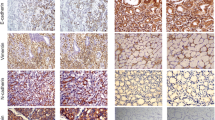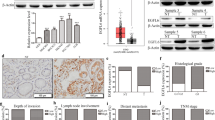Abstract
In human gastric cancer (GC), the upregulation of FOXK1 and vimentin is frequently observed in cancer cells and correlates with increased malignancy. We report that FOXK1 synergizes with vimentin to promote GC invasion and metastasis via the induction of epithelial-mesenchymal transition (EMT). We showed that higher expression levels of FOXK1 were significantly associated with GC development. FOXK1 can physically interact with and stabilize vimentin. Moreover, a positive correlation between the expression of FOXK1 and vimentin was found in GC cells. Higher expression levels of these two proteins were significantly associated with differentiation, lymph node metastasis, AJCC stage, and poorer prognosis. Furthermore, the coexpression of FOXK1 and vimentin enhances cell metastasis through the induction of EMT in GC cells. However, the siRNA-mediated repression of vimentin in FOXK1-overexpressing cells reversed the EMT-like phenotype and reduced GC cell migration and invasion in vitro and in vivo. Altogether, our findings suggest that the vimentin-FOXK1 axis provides new insights into the molecular mechanisms underlying EMT regulation during GC progression and metastasis.






Similar content being viewed by others

Abbreviations
- EMT:
-
Epithelial-to-mesenchymal transition
- FOX:
-
The forkhead box
- AJCC:
-
American Joint Committee on Cancer
- GC:
-
Gastric cancer
- TMA:
-
Tissue microarray
References
Lo PK, Lee JS, Liang X, Sukumar S (2016) The dual role of FOXF2 in regulation of DNA replication and the epithelial-mesenchymal transition in breast cancer progression. Cell Signal 28:1502–1519
Williamson EA, Wolf I, O’Kelly J, Bose S, Tanosaki S, Koeffler HP (2006) BRCA1 and FOXA1 proteins coregulate the expression of the cell cycle-dependent kinase inhibitor p27(Kip1). Oncogene 25:1391–1399
Weng W, Okugawa Y, Toden S, Toiyama Y, Kusunoki M, Goel A (2016) FOXM1 and FOXQ1 are promising prognostic biomarkers and novel targets of tumor-suppressive miR-342 in human colorectal cancer. Clin Cancer Res 22:4947–4957
Kim IM, Ackerson T, Ramakrishna S, Tretiakova M, Wang IC, Kalin TV, Major ML, Gusarova GA, Yoder HM, Costa RH, Kalinichenko VV (2006) The forkhead box m1 transcription factor stimulates the proliferation of tumor cells during development of lung cancer. Cancer Res 66:2153–2161
Milewski D, Balli D, Ustiyan V, le T, Dienemann H, Warth A, Breuhahn K, Whitsett JA, Kalinichenko VV, Kalin TV (2017) FOXM1 activates AGR2 and causes progression of lung adenomas into invasive mucinous adenocarcinomas. PLoS Genet 13:e1007097
Ji X, Ji Y, Wang W, Xu X (2018) Forkhead box N1 inhibits the progression of non-small cell lung cancer and serves as a tumor suppressor. Oncol Lett 15:7221–7230
Li P, Yu Z, He L, Zhou D, Xie S, Hou H, Geng X (2017) Knockdown of FOXK1 inhibited the proliferation, migration and invasion in hepatocellular carcinoma cells. Biomed Pharmacother 92:270–276
Li L, Gong M, Zhao Y, Zhao X, Li Q (2017) FOXK1 facilitates cell proliferation through regulating the expression of p21, and promotes metastasis in ovarian cancer. Oncotarget 8:70441–70451
Chen F, Xiong W, Dou K, Ran Q (2017) Knockdown of FOXK1 suppresses proliferation, migration, and invasion in prostate cancer cells. Oncol Res 25:1261–1267
Chen D, Wang K, Li X, Jiang M, Ni L, Xu B, Chu Y, Wang W, Wang H, Kang H, Wu K, Liang J, Ren G (2017) FOXK1 plays an oncogenic role in the development of esophageal cancer. Biochem Biophys Res Commun 494:88–94
Peng Y, Zhang P, Huang X, Yan Q, Wu M, Xie R, Wu Y, Zhang M, Nan Q, Zhao J, Li A, Xiong J, Ren Y, Bai Y, Chen Y, Liu S, Wang J (2016) Direct regulation of FOXK1 by C-jun promotes proliferation, invasion and metastasis in gastric cancer cells. Cell Death Dis 7:e2480
Wu Y, Peng Y, Wu M, Zhang W, Zhang M, Xie R, Zhang P, Bai Y, Zhao J, Li A, Nan Q, Chen Y, Ren Y, Liu S, Wang J (2016) Oncogene FOXK1 enhances invasion of colorectal carcinoma by inducing epithelial-mesenchymal transition. Oncotarget 7:51150–51162
Zhang P, Tang WM, Zhang H, Li YQ, Peng Y, Wang J, Liu GN, Huang XT, Zhao JJ, Li G, Li AM, Bai Y, Chen Y, Ren YX, Li GX, Wang YD, Liu SD, Wang JD (2017) MiR-646 inhibited cell proliferation and EMT-induced metastasis by targeting FOXK1 in gastric cancer. Br J Cancer 117:525–534
Wang W, Li X, Lee M, Jun S, Aziz KE, Feng L, Tran MK, Li N, McCrea PD, Park JI, Chen J (2015) FOXKs promote Wnt/beta-catenin signaling by translocating DVL into the nucleus. Dev Cell 32:707–718
Rosivatz E, Becker I, Specht K, Fricke E, Luber B, Busch R, Höfler H, Becker KF (2002) Differential expression of the epithelial-mesenchymal transition regulators snail, SIP1, and twist in gastric cancer. Am J Pathol 161:1881–1891
Shankar J, Nabi IR (2015) Actin cytoskeleton regulation of epithelial mesenchymal transition in metastatic cancer cells. PLoS One 10:e0119954
Shankar J, Messenberg A, Chan J, Underhill TM, Foster LJ, Nabi IR (2010) Pseudopodial actin dynamics control epithelial-mesenchymal transition in metastatic cancer cells. Cancer Res 70:3780–3790
Lee S, Yang Y, Fishman D, Banaszak Holl MM, Hong S (2013) Epithelial-mesenchymal transition enhances nanoscale actin filament dynamics of ovarian cancer cells. J Phys Chem B 117:9233–9240
Huang J, Xiao D, Li G, Ma J, Chen P, Yuan W, Hou F, Ge J, Zhong M, Tang Y, Xia X, Chen Z (2014) EphA2 promotes epithelial-mesenchymal transition through the Wnt/beta-catenin pathway in gastric cancer cells. Oncogene 33:2737–2747
Cai J, Feng D, Hu L, Chen H, Yang G, Cai Q, Gao C, Wei D (2015) FAT4 functions as a tumour suppressor in gastric cancer by modulating Wnt/beta-catenin signalling. Br J Cancer 113:1720–1729
Otsuki S, Inokuchi M, Enjoji M, Ishikawa T, Takagi Y, Kato K, Yamada H, Kojima K, Sugihara K (2011) Vimentin expression is associated with decreased survival in gastric cancer. Oncol Rep 25:1235–1242
Andreolas C, Kalogeropoulou M, Voulgari A, Pintzas A (2008) Fra-1 regulates vimentin during Ha-RAS-induced epithelial mesenchymal transition in human colon carcinoma cells. Int J Cancer 122:1745–1756
Xie R, Wang J, Tang W, Li Y, Peng Y, Zhang H, Liu G, Huang X, Zhao J, Li A, Gong W, Chen Y, Ren Y, Wang Y, Li G, Liu S, Wang J (2017) Rufy3 promotes metastasis through epithelial-mesenchymal transition in colorectal cancer. Cancer Lett 390:30–38
Liu CY, Lin HH, Tang MJ, Wang YK (2015) Vimentin contributes to epithelial-mesenchymal transition cancer cell mechanics by mediating cytoskeletal organization and focal adhesion maturation. Oncotarget 6:15966–15983
Yilmaz M, Christofori G (2009) EMT, the cytoskeleton, and cancer cell invasion. Cancer Metastasis Rev 28:15–33
Xie R, Wang J, Liu X, Wu L, Zhang H, Tang W, Li Y, Xiang L, Peng Y, Huang X, Bai Y, Liu G, Li A, Wang Y, Chen Y, Ren Y, Li G, Gong W, Liu S, Wang J (2017) RUFY3 interaction with FOXK1 promotes invasion and metastasis in colorectal cancer. Sci Rep 7:3709
Mendez MG, Kojima S, Goldman RD (2010) Vimentin induces changes in cell shape, motility, and adhesion during the epithelial to mesenchymal transition. FASEB J 24:1838–1851
Raymond WA, Leong AS (1989) Vimentin--a new prognostic parameter in breast carcinoma? J Pathol 158:107–114
Ngan CY, Yamamoto H, Seshimo I, Tsujino T, Man-i M, Ikeda JI, Konishi K, Takemasa I, Ikeda M, Sekimoto M, Matsuura N, Monden M (2007) Quantitative evaluation of vimentin expression in tumour stroma of colorectal cancer. Br J Cancer 96:986–992
Domagala W, Lasota J, Weber K, Osborn M (1989) Endothelial cells help in the diagnosis of primary versus metastatic carcinoma of the liver in fine needle aspirates. An immunofluorescence study with vimentin and endothelial cell-specific antibodies. Anal Quant Cytol Histol 11:8–14
Thomas K, Mayston V (1987) Vimentin as a tumour marker. Histopathology 11:991
Zhai X, Zhu H, Wang W, Zhang S, Zhang Y, Mao G (2014) Abnormal expression of EMT-related proteins, S100A4, vimentin and E-cadherin, is correlated with clinicopathological features and prognosis in HCC. Med Oncol 31:970
Liu T, Zhang X, Shang M, Zhang Y, Xia B, Niu M, Liu Y, Pang D (2013) Dysregulated expression of Slug, vimentin, and E-cadherin correlates with poor clinical outcome in patients with basal-like breast cancer. J Surg Oncol 107:188–194
Usami Y, Satake S, Nakayama F, Matsumoto M, Ohnuma K, Komori T, Semba S, Ito A, Yokozaki H (2008) Snail-associated epithelial-mesenchymal transition promotes oesophageal squamous cell carcinoma motility and progression. J Pathol 215:330–339
Lim JC, Koh VC, Tan JS et al (2015) Prognostic significance of epithelial-mesenchymal transition proteins Twist and Foxc2 in phyllodes tumours of the breast. Breast Cancer Res Treat 150:19–29
Lange K, Kammerer M, Hegi ME, Grotegut S, Dittmann A, Huang W, Fluri E, Yip GW, Gotte M, Ruiz C, Orend G (2007) Endothelin receptor type B counteracts tenascin-C-induced endothelin receptor type A-dependent focal adhesion and actin stress fiber disorganization. Cancer Res 67:6163–6173
Yang MH, Wu MZ, Chiou SH, Chen PM, Chang SY, Liu CJ, Teng SC, Wu KJ (2008) Direct regulation of TWIST by HIF-1alpha promotes metastasis. Nat Cell Biol 10:295–305
Funding
This study was supported by grants from the National Natural Science Funds of China (81672875 and 81772964) and “President Foundation of Nanfang Hospital, Southern Medical University” (2012B009, 2013Z007) and high-level topic-matching funds of Nanfang Hospital (201347 and G201227). Guangdong Provincial Key Laboratory of Gastroenterology, Department of Gastroenterology, Nanfang Hospital, Southern Medical University; Guangzhou Pilot Project of Clinical and Translational Research Center (early gastrointestinal cancer, No. 7415696196402).
Author information
Authors and Affiliations
Corresponding authors
Ethics declarations
Competing interests
The authors declare that they have no conflict of interest.
Ethics approval
This study was conducted with the approval of the ethics committee of Southern Medical University.
Patient consent
Obtained.
Provenance and peer review
Not commissioned; externally peer reviewed.
Additional information
Article Summary
Our findings suggest that the vimentin-FOXK1 axis has provided new insights into the molecular mechanisms underlying EMT regulation during GC progression and metastasis.
Electronic supplementary material
Supplementary Fig. 1
Vimentin physically interacts with FOXK1 in SCG7901 cells. (A) Diagram showing the full-length and truncated (N terminus, FHA domain and C terminus) FOXK1 fragments. Immunoprecipitation was performed using cell lysates from SCG7901 cells transfected with the above four constructs. Anti-HA or normal mouse (nm) IgG was used as the bait to detect vimentin. The IP blot was probed with the indicated antibodies to show the input. (B) Full-length, N-terminal, IF rod domain or C-terminal vimentin protein fragments interacted with FOXK1. All images represent two or three independent experiments with identical results. (C) FOXK1 increases the stability of vimentin via a posttranslational mechanism. SCG7901 cells were transfected with vimentin. Twenty-four hours after transfection, cycloheximide (CHX) was added to the culture, and the levels of the FOXK1 protein at different time points were determined via western blotting. The half-life of FOXK1 increased from 3 to 7 h in the presence of vimentin. (PNG 63 kb)
Supplementary Fig. 2.
FOXK1 expression is positively correlated with vimentin expression in GC cells. These images are representative of 3 independent experiments with identical results. (PNG 242 kb)
Supplementary Fig. 3.
Assessment of migration and invasion. Cells stably transfected with vector or FOXK1 were transfected with vimentin siRNA 48 h later, and the migratory (A) and invasive (B) abilities of the cells were decreased. ** P < 0.05 and *** P < 0.01. The experiments were repeated at least three times. (PNG 651 kb)
Supplementary Fig. 4.
Gelatin zymography assay for MMP-2 and MMP-9 levels in SCG7901 cells. (A) Representative gelatin zymography results showing MMP2 and MMP9 activity. (B) Quantitative analysis of (A). The bars represent the intensity value of the bright band and were used for statistical analysis. N = 3, ****P < 0.001, vector vs. FOXK1 and FOXK1 vs. FOXK1-vimentin siRNA. (PNG 753 kb)
Rights and permissions
About this article
Cite this article
Zhang, H., Wu, X., Xiao, Y. et al. Coexpression of FOXK1 and vimentin promotes EMT, migration, and invasion in gastric cancer cells. J Mol Med 97, 163–176 (2019). https://doi.org/10.1007/s00109-018-1720-z
Received:
Revised:
Accepted:
Published:
Issue Date:
DOI: https://doi.org/10.1007/s00109-018-1720-z



